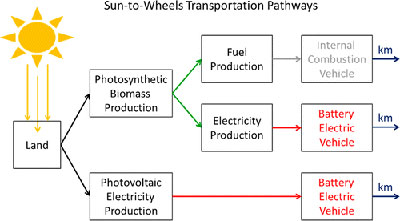Which is a better source to power electric vehicles – biomass generated electricity or solar?
Not only are biofuels derived from plants like corn or switchgrass being used and promoted as an alternative to oil, but they are also viewed as a source of electricity that could charge electric cars, in addition to providing power.
But planting these crops is increasingly seen as a threat to the food supply and habitats, especially since known invasive plants could be widely used.
Why not use direct solar PV electricity instead?
An academic study compares biomass and solar PV, examining the amount of land required, lifecycle greenhouse gas emissions, and necessary fossil fuel inputs.
Solar wins hands down.
"PV is orders of magnitude more efficient than biofuels pathways in terms of land use – 30, 50, even 200 times more efficient – depending on the specific crop and local conditions," says Roland Geyer, a professor at the University of California, Santa Barbara who led the research. "You get the same amount of energy using much less land, and PV doesn’t require farm land."

Researchers from University of California, Santa Barbara and the Norwegian University of Science and Technology studied several ways of using sunlight to power cars: converting corn, switchgrass or other plants into ethanol; converting energy crops into electricity rather than producing ethanol; and using solar PV to convert sunlight directly into electricity.
They found that even the most efficient biomass crops require 29 times more land than solar PV used in the same locations and that PV-powered electric vehicles have the lowest greenhouse gas emissions across their lifecycle across the US. Solar PV also requires the lowest fossil fuel inputs, except in locations where there are very high hypothetical yields of switchgrass of 16 or more tons per hectare."
Not surprisingly, corn-derived ethanol requires the most land, has the highest greenhouse gas emissions and fossil fuels inputs to grow the crop.
Read the paper, "Spatially Explicit Life Cycle Assessment of Sun-to-Wheels Transportation Pathways in the US":

